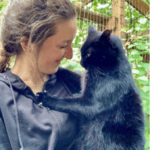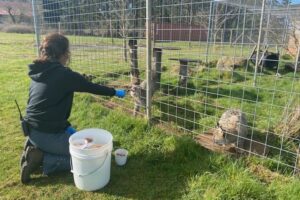A Day in the Life of a Keeper
Part 1: The Morning Routine
A commonly asked question the keepers receive is, “What do you do as a keeper? What does the day look like?”
This is a great question and one we’d like to address for all those curious souls, especially those potential interns wondering what it would be like to work at WCR. This week we’ll give you a glimpse into our busy morning routine.
Our days typically start around 7 AM, (we work ten-hour days) where we all stagger sleepily, coffee in hand, into Food Prep. Food Prep could be referred to as our Keeper HQ – it’s where you’ll find all the cleaning supplies, the laundry/locker room, the fridge where we keep all the diets for the next day, and all the medications. The walls are covered with whiteboards detailing how much food each cat gets, what doses of medications some of them need, projects to be completed and, of course, the daily schedule and to-do list.
We spend the first couple hours of the morning weighing out the diets (most of which are made the day before), adding the needed meds, catching up on notes, and talking out the plan for the day. Then, as the diets are completed, we separate and feed our respective areas.
The sanctuary is sectioned off into six sections, or perimeters – Alpha (tigers & lions), Bravo (cougars), Echo (cheetahs), Charlie & Delta (servals and bobcats), and the small cat pens where we house the smaller savannahs, Bengals and domestic cats. Typically, one keeper feeds “big guys” – Alpha, Bravo, and Echo –another handles Charlie/Delta and a third takes the small cats.
During feeding, we pay attention to their behaviors. Is someone eating slower than usual? Did another cat sift out all their meds and refuse to take them? Did so-and-so not eat as much as we expected, or only eat one kind of meat? How the cats eat can tell us much about their overall health, so paying attention to a seemingly small detail is a very important part of our jobs. Any irregularities we make sure to keep notes of so we can notice patterns of behaviors or any potential warning signs.
Feeding takes two to three hours, and post-feeding includes washing all the dishes and preparing diets for the big guys and small cats for the following day. Charlie/Delta we make day-of, so we don’t worry so much about that. Diet prep includes weighing out the appropriate amount of meat for each cat, paying attention to their likes and dislikes to ensure they eat everything! Just like your house cats, some of our cats can be quite picky, like Safari who refuses to eat liver or Uche who really loves a crunchy turkey gizzard or chicken neck.
We feed them a combination of raw chicken, beef, and Nebraska horsemeat, as well as the occasional venison, rabbit, quail, or fish, as friends of the sanctuary, will sometimes donate different kinds of meat if they have an overabundance. We’ve noticed how sometimes the cats grow bored with their food occasionally, so we always get excited when people help us freshen it up for them!
During diet prep, it’s inevitable that a keeper will walk into Food Prep and ask, “Hey, has livestock been fed?” In addition to the cats, we make sure the donkeys, cows, pigs, sheep, chickens, and turkey get their breakfast, too...it’s hard to forget about them, the donkeys will yell at anyone who walks by the fence as a reminder to bring fresh hay asap.
Once all that’s been completed, it’s time for us to take a lunch break before starting in on the afternoon’s tasks.





